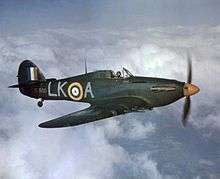No. 520 Squadron RAF
| No. 520 Squadron RAF | |
|---|---|
| Active | 20 September 1943 – 25 April 1946 |
| Country |
|
| Branch |
|
| Role | meteorological |
| Part of | HQ RAF Gibraltar, Coastal Command[1] |
| Motto(s) | Tomorrow's Weather Today[2] |
| Insignia | |
| Squadron Badge heraldry | A dove holding in the beak an olive branch[2] |
| Squadron Codes | 2M (Sep 1943 – Apr 1946)[3][4] |
No. 520 Squadron RAF was a meteorological squadron of the Royal Air Force during the Second World War.
History
The squadron was formed at RAF Gibraltar on 20 September 1943 from 1403 Flight.[5][6] Equipped with Lockheed Hudsons, it was tasked with collecting meteorological data from both the Mediterranean and Atlantic. In February 1944 it was re-equipped with Handley Page Halifaxes and these were supplemented by Supermarine Spitfires, although the Spitfires were replaced with Hawker Hurricanes a few months later. In September 1944 the squadron absorbed 1500 (BAT) Flight and its Miles Martinets, which were used for target towing.[2] The squadron also operated the Hudson again and also the Vickers Warwick. The squadron continued to serve for a while after the war was over, and was even given an air-sea rescue task,[2] using the Warwicks, but was disbanded at Gibraltar on 25 April 1946.[5]
Aircraft operated

| From | To | Aircraft | Variant |
|---|---|---|---|
| September 1943 | March 1944 | Lockheed Hudson | Mk.III |
| September 1943 | June 1944 | Gloster Gladiator | Mk.II |
| February 1944 | June 1945 | Handley Page Halifax | Mk.V |
| February 1944 | June 1944 | Supermarine Spitfire | Mk.Vb |
| June 1944 | April 1946 | Hawker Hurricane | Mk.IIc |
| September 1944 | December 1945 | Miles Martinet | Mk.I |
| January 1945 | October 1945 | Lockheed Hudson | Mk.III |
| April 1945 | April 1946 | Handley Page Halifax | Mk.III |
| August 1945 | April 1946 | Vickers Warwick | Mk.I |
| October 1945 | January 1946 | Lockheed Hudson | Mk.VI |
Squadron bases
| From | To | Base | Remark |
|---|---|---|---|
| 20 September 1943 | 25 April 1946 | RAF Gibraltar | already in use with 1403 Flight since 6 March 1943[6] |
See also
References
Notes
- ↑ Delve 1994, pp. 64, 73.
- 1 2 3 4 5 6 Halley 1988, p. 398.
- ↑ Bowyer and Rawlings 1979, p. 75.
- ↑ Flintham and Thomas 2003, p. 56.
- 1 2 3 4 Jefford 2001, p. 97.
- 1 2 Sturtivant and Hamlin 2007, p. 120.
- 1 2 Rawlings 1982, p. 254.
Bibliography
- Bowyer, Michael J.F. and John D.R. Rawlings. Squadron Codes, 1937–56. Cambridge, UK: Patrick Stephens Ltd., 1979. ISBN 0-85059-364-6.
- Delve, Ken. The Source Book of the RAF. Shrewsbury, Shropshire, UK: Airlife Publishing, 1994. ISBN 1-85310-451-5.
- Flintham, Vic and Andrew Thomas. Combat Codes: A full explanation and listing of British, Commonwealth and Allied air force unit codes since 1938. Shrewsbury, Shropshire, UK: Airlife Publishing Ltd., 2003. ISBN 1-84037-281-8.
- Halley, James J. The Squadrons of the Royal Air Force & Commonwealth, 1981–1988. Tonbridge, Kent, UK: Air-Britain (Historians) Ltd., 1988. ISBN 0-85130-164-9.
- Jefford, Wing Commander C.G., MBE,BA,RAF (Retd). RAF Squadrons, a Comprehensive Record of the Movement and Equipment of all RAF Squadrons and their Antecedents since 1912. Shrewsbury, Shropshire, UK: Airlife Publishing, 2001. ISBN 1-84037-141-2.
- Rawlings, John D.R. Coastal, Support and Special Squadrons of the RAF and their Aircraft. London: Jane's Publishing Company Ltd., 1982. ISBN 0-7106-0187-5.
- Sturtivant, Ray, ISO and John Hamlin. RAF Flying Training And Support Units since 1912. Tonbridge, Kent, UK: Air-Britain (Historians) Ltd., 2007. ISBN 0-85130-365-X.
External links
| Wikimedia Commons has media related to No. 520 Squadron RAF. |
